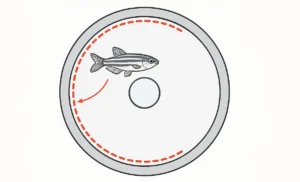

The spectrophotometer is a common optical device that measures the intensity of light relative to color (or wavelength). In the lab, they are used to determine how much light is absorbed by a colored chemical dissolved in the solution. This allows us to calculate the concentration or purity of chemicals, analyze specific chemical characteristics, and follow and measure chemical reactions in real-time.
As spectrophotometers use colored light to measure the absorbance of colored chemicals, let’s briefly describe the basic principles of color and light absorbance.
The colors we see are light waves of electromagnetic radiation and each color has a different wavelength. The wavelengths of light we can see (visible) are between 380 nanometres (nm) in the violet range (V) to 750 nm in the red range (R). Figure 1 shows the visible spectrum.

Figure 1: Visible light spectrum. Numbers represent wavelength (nm) (source: Wikimedia Commons, public domain).
Colored chemicals have color because they absorb some light waves while reflecting others. So, a red chemical absorbs all light waves and reflects the red wavelength light back to our eyes. And, a blue chemical reflects all light except for light with blue wavelengths.
Figure 2 shows the basic components of a spectrophotometer. Essentially, light from a specific source is split into different wavelengths (colors), then a selected wavelength passes through the sample and its final intensity is measured. Let’s break down each component.

Figure 2: Basic components of a spectrophotometer (source: Wikimedia Commons, CC-BY-SA).
The light source for a spectrophotometer that measures visible light uses an incandescent lamp with a tungsten filament. They look like very small light bulbs with two metal prongs.
The monochromator takes the light from the lamp and splits it into different colors or wavelengths. It works like a prism that bends light, separating the light into different wavelengths by refraction.
The aperture is simply a hole that creates a light beam. The size of the hole can be adjusted larger or smaller.
The cuvette is a small square vial that holds the solution with the colored chemical we want to measure (sample). They can be made of glass or plastic. They can hold volumes from 0.1 ml to 5ml.
The photodetector is a device that can convert light into an electrical signal. And the amplifier boosts the electrical signal to increase the sensitivity.
Spectrophotometers have a numerical readout to quantify the amount of light that’s absorbed as it passes through the sample. Older models use an analog needle and dial while newer models have digital readouts.
Spectrophotometers are used to measure the amount of light that’s absorbed by a colored chemical in a solution. But how do we convert the numbers on the output into usable information? To answer this question, we must understand the optical theory of absorbance described by the Beer-Lambert Law.
The Beer-Lambert Law describes the relationship between absorbance and the amount of chemical in solution and the distance light has to travel through the sample.
The Beer-Lambert Law is A = εcl, where A is the absorbance (no units), ε = molar extinction coefficient (M-1 cm-1), c = concentration of the substance (M), and l = path length of the light (cm).
Spectrophotometers have a panel area to set wavelengths, adjust other functions, and the output display. And they have a sample area with a square sample holder that nicely fits a cuvette, sitting directly in the path of the light beam shining on the detector. The sample area is also closed off to the outside light to prevent extra light from affecting the readings.
If we want to know the absorbance of a specific chemical in a solution, we must also account for the absorbance of the solution itself. So, we make two cuvettes, one with solution only (reference or blank), and one with solution plus the chemical we want to measure.
The reference solution is first put into the sample holder. The spectrophotometer has a button to “tare” the absorbance reading to A=0. Then the sample is put into the holder and the absorbance of the chemical is read on the display.
The absorbance spectrum of a chemical is the amount of light it absorbs at all the different wavelengths from violet to red. The spectrophotometer measures the absorbance of each different wavelength by adjusting the monochromator. Depending on the color of the solution, the absorbance will peak at specific wavelengths.
For example, figure 3 shows the absorbance spectrum of two types of chlorophyll (a,b), the biochemicals that make plants green. The plot shows the absorbance vs. wavelength(nm). We see absorbance peaks at either end for the light spectra. Chlorophyll absorbs blue and red light and reflects green light.

Figure 3. Absorbance spectrum of chlorophyll-a,-b (source: Wikimedia Commons, CC-BY-SA).
Measuring the concentration of a chemical in a solution using a spectrophotometer is its most common application. By rearranging the Beer-Lambert equation (A = εcl) to c= A/εl, we can calculate the concentration directly from an absorbance reading. Since the path length (l) is 1 cm, all we need is the extinction coefficient (ε). Extinction coefficients are typically already known so it’s easy to just plug the number into the equation and calculate concentration.
For example, the ε for chlorophyll-a is 105 M−1 cm−1. Therefore, a reading of A=1.0 would mean the concentration of chlorophyll = 1.0/105 = 0.00001 Molar (M) or 0.01 mM (or 10µM).
An extinction coefficient can also be determined from an absorbance spectrum. In figure 3, there are two absorbance peaks for chlorophyll-a, one in the blue region (430nm) and the other in the red region (662nm). If a known concentration of chlorophyll-a is measured, then ε (at 430nm or 662nm) can be calculated by ε = A/c.
Chemical kinetics is the study of reactions over time. Using a spectrophotometer, we can monitor a chemical reaction as it occurs in real-time. In the same way, we add a sample with one reactant to the cuvette and set the reading to zero. Then we add a second reactant, mix, and take absorbance readings of the product at various time points. By converting absorbance to concentration, we can plot the concentration versus time and calculate the rate of the reaction. And, by changing the concentrations of reactants, we analyze the nature of the chemical reaction itself.
We’ve discussed spectrophotometers that use visible light to measure colored chemicals. There are also spectrophotometers that use ultraviolet light (UV), and some that use more than one light beam.
Most visible spectrophotometers also use UV light to measure non-colored chemicals that absorb UV light using wavelengths between 180nm to 400nm. Instead of a tungsten lamp as the light source, UV spectrophotometers use a deuterium lamp (D2). Also, special cuvettes made from quartz are needed as glass and most plastic cuvettes absorb UV light. There are, however, UV cuvettes made from special plastics.
The most common use for UV spectrophotometer is to measure the concentration of DNA and proteins in solution. DNA absorbs UV light at 260nm while proteins absorb UV light at 280nm.
Single beam spectrophotometers have a single beam that shines through the sample. Before the sample is read, however, a reference sample must be measured. With a double-beam spectrophotometer, there are two beams, one for the reference sample and one for the test sample measured at the same time.
The primary limitation of spectrophotometers is they can’t measure chemicals that don’t have a color or absorb UV light. We can, however, add chemicals that react with uncolored compounds to produce a colored product that can be measured.
Spectrophotometers work best with dilute solutions that have an absorbance reading between 0 and 1. As described above, a sample that transmits only 10% of the light (90% absorbed) gives a reading of 1. Likewise, a more concentrated sample that absorbs more light and transmits 1% of the light (99% absorbed) gives a reading of 2. So, the most precise readings of absorbance are between 0 and 1 (0 to 90% absorbance). If a sample is too concentrated, it must be diluted, the absorbance read, then multiplied by the dilution factor.
Fortunately, spectrophotometers are built to need very little maintenance. Apart from keeping them clean and wiping up from liquid spills, the light sources need to be changed when they no longer produce enough light. It’s best to always have extra lamps on hand in case the lamps burn out.
Spectrophotometers are one of the most useful scientific instruments to detect, measure, and characterize chemicals in solutions. With chemicals that absorb light, their absorbance spectra and concentrations can be determined quickly and easily. And they can also be used to measure chemical reaction rates in real-time.

Monday – Friday
9 AM – 5 PM EST
DISCLAIMER: ConductScience and affiliate products are NOT designed for human consumption, testing, or clinical utilization. They are designed for pre-clinical utilization only. Customers purchasing apparatus for the purposes of scientific research or veterinary care affirm adherence to applicable regulatory bodies for the country in which their research or care is conducted.